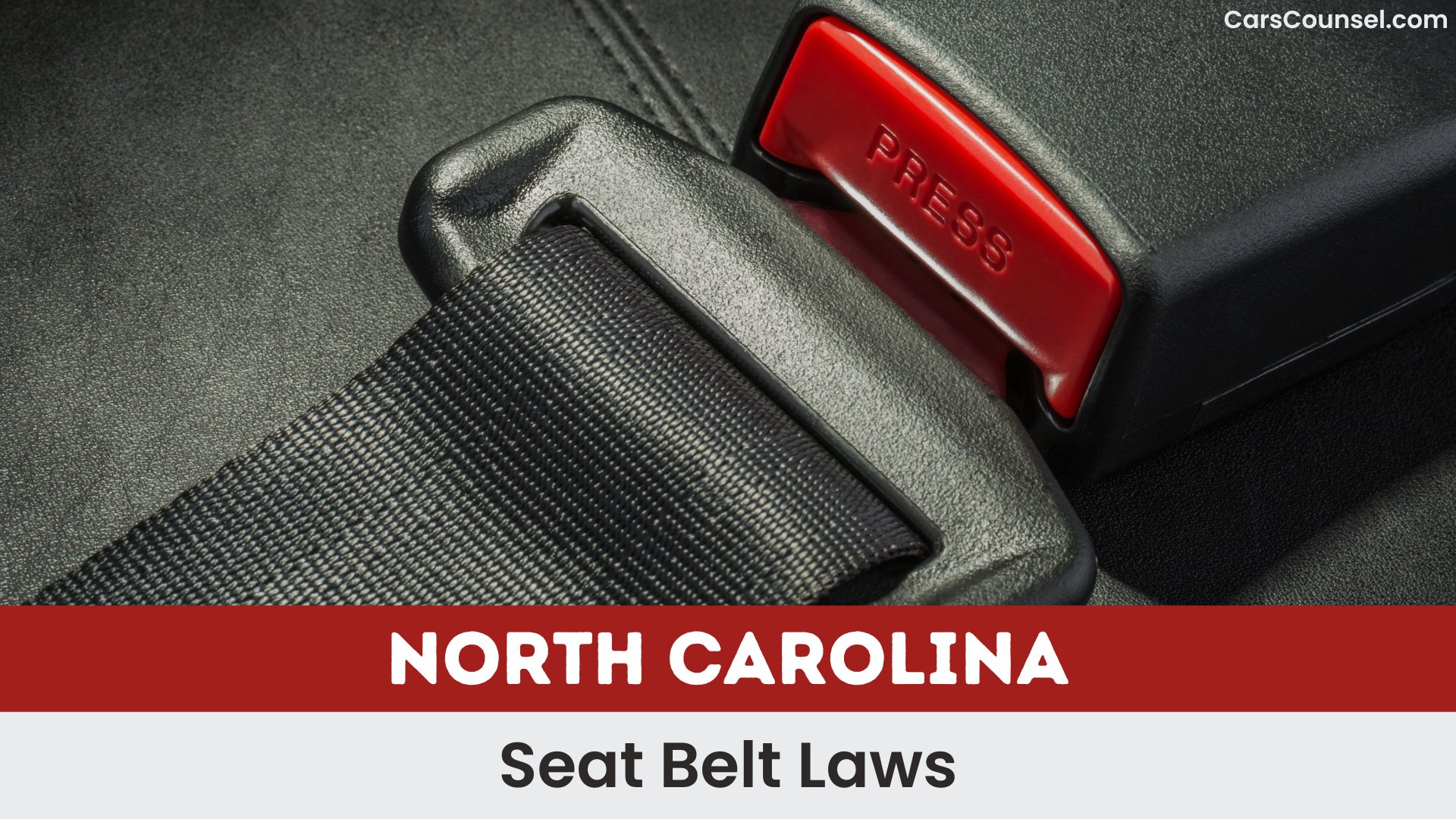In North Carolina, understanding seat belt laws is essential for safety, compliance, and responsibility. You must know who is covered, what vehicles apply, and the specifics of restraint requirements. Exemptions exist, but they’re limited.
As a driver, you hold significant responsibility, and the penalties for non-compliance can add up quickly. What happens if you overlook these details? The implications extend beyond mere fines.

Quick Navigation
Key Takeaways
- In North Carolina, all passengers aged 16 and older must wear seat belts in both front and back seats.
- The law mandates appropriate child safety seats for children under 16, with drivers responsible for securing them.
- Fines for non-compliance are $25.50 for front-seat passengers and $10 for back-seat passengers.
- Exemptions apply to individuals with medical conditions and vehicles manufactured before specific years.
- Drivers must ensure all passengers under 16 are secured, while those 16 and older are responsible for their own seat belt use.
Ages/Positions Covered
In North Carolina, the seat belt laws are clear: if you’re 16 or older, you’re required to buckle up, whether you’re in the front or back seat.
These laws apply to all drivers and passengers aged 16 and older, emphasizing the importance of being properly restrained.
For those under 16, the NC Child Passenger Safety law mandates the use of an appropriate child passenger restraint system.
As a driver, you’re responsible for ensuring that all younger passengers are secured.
Non-compliance can result in fines—$25.50 for front seat occupants and $10 for those in the back seat.
Vehicles Covered
North Carolina’s seat belt laws extend to a wide range of vehicles, ensuring that safety standards are met.
Here’s what you need to know about the vehicles covered by the law:
- All passenger vehicles manufactured after 1967 must comply with the seat belt law.
- Light trucks, vans, and SUVs made after 1971 are also included.
- Vehicles manufactured before 1968 and light trucks or vans made before 1972 are exempt.
Restraint Required
Understanding the vehicles covered by North Carolina’s seat belt laws highlights the importance of proper restraint for all occupants. Every occupant of a motor vehicle must wear seat belts, including lap and shoulder belts, to guarantee safety. Misuse, such as placing belts behind the back, is prohibited.
| Occupant Type | Required Restraint | Special Considerations |
|---|---|---|
| Front-seat passengers | Lap and shoulder belt | Must be properly restrained |
| Backseat passengers | Lap and shoulder belt | Safety seats for children |
| Children | Child safety seat | Age and weight regulations |
| Lap-belt-only seats | Must use lap belt | Compliance with regulations |
Awareness and adherence to these laws are critical for safety.
Exemptions
While seat belt laws are essential for safety, certain exemptions exist in North Carolina that recognize specific circumstances. You should be aware of the following exemptions:
- Individuals with medical conditions that prevent them from wearing seat belts.
- Vehicles manufactured before 1968 and light trucks or vans made before 1972.
- Rural letter carriers, newspaper delivery personnel, and drivers delivering goods at speeds not exceeding 20 mph.
Additionally, occupants of motor homes, except for drivers and front seat passengers, are also exempt.
Understanding these exemptions can help you navigate the seat belt law effectively while ensuring safety.
Responsibility and Penalties
Seat belt laws in North Carolina place a significant responsibility on drivers and passengers alike.
Drivers must guarantee all passengers under 16 are properly restrained in seat belts or child safety seats. Passengers aged 16 and older are responsible for their own seat belt use, facing penalties of $25.50 for drivers and front-seat passengers, and $10 for rear-seat passengers.
Particularly, rear-seat violations incur no court costs or points. Failure to secure children under 16 results in a capped penalty of $25, with no extra penalties for multiple violations.
Non-compliance can also lead to primary enforcement actions by law enforcement.
Seat Belt Laws by State: Primary vs Secondary Enforcement, Base Fines & Child Seat Rules
| State | Description |
|---|---|
| Alabama | Everyone 15+ must buckle in all seats; rear-seat adults are secondary. Enforcement: Primary (rear secondary). Fine: $25. |
| Alaska | All occupants 16+ must wear seat belts in any seat. Enforcement: Primary. Fine: $15. |
| Arizona | Seat belts required in the front for 8+; ages 8–15 in all seats. Enforcement: Secondary for adults. Fine: $10. |
| Arkansas | Front seat 15+ must belt up; kids under 15 must be restrained. Enforcement: Primary. Fine: $45. |
| California | All occupants 16+ must belt in every seat; strict child-seat rules. Enforcement: Primary. Fine: $20 (adult belt; higher for child). |
| Colorado | Front seat 18+ must wear belts; all under 16 must be restrained. Enforcement: Secondary (adult belt). Fine: $71 (adult belt). |
| Connecticut | All 8+ must buckle in any seat; rear 16+ is secondary. Enforcement: Primary (rear 16+ secondary). Fine: $50. |
| Delaware | All 16+ must wear belts in every seat. Enforcement: Primary. Fine: $25. |
| Florida | Front seat 6+ and all 6–17 must belt; strict child-seat rules. Enforcement: Primary. Fine: $30 (adult belt). |
| Georgia | Adults must belt (front); ages 8–17 must belt in all seats. Enforcement: Primary. Fine: $15 (adult belt). |
| Hawaii | All 8+ must wear belts in every seat. Enforcement: Primary. Fine: $45. |
| Idaho | All 7+ must wear belts; enforcement focuses on front for adults. Enforcement: Secondary. Fine: $10. |
| Illinois | Everyone 16+ must belt in any seat. Enforcement: Primary. Fine: $25. |
| Indiana | All occupants must wear seat belts, any seat. Enforcement: Primary. Fine: $25. |
| Iowa | Front seat 18+ must belt; all 6–17 must be restrained. Enforcement: Primary (adult front). Fine: $25. |
| Kansas | 14+ must belt (all seats); rear 18+ secondary. Enforcement: Primary (rear 18+ secondary). Fine: $30 adults / $60 ages 14–17. |
| Kentucky | All 8+ must belt in any seat; boosters for shorter kids. Enforcement: Primary. Fine: $25 (adult belt). |
| Louisiana | All 13+ must wear belts in every seat. Enforcement: Primary. Fine: $50. |
| Maine | All 18+ must wear belts in all seats; strong child-seat rules. Enforcement: Primary. Fine: $50. |
| Maryland | All 16+ must belt in any seat; rear adults secondary. Enforcement: Primary (rear secondary). Fine: $50. |
| Massachusetts | All 13+ must belt in any seat. Enforcement: Secondary. Fine: $25. |
| Michigan | Front seat 16+ must belt; all 8–15 must belt any seat. Enforcement: Primary (adult front). Fine: $25 (adult belt). |
| Minnesota | All 18+ must wear belts in all seats. Enforcement: Primary. Fine: $25 (adult belt). |
| Mississippi | All 7+ must belt in any seat. Enforcement: Primary. Fine: $25. |
| Missouri | Front seat 16+ must belt; child belts are primary. Enforcement: Secondary for adults (primary for <16). Fine: $10 (adult belt). |
| Montana | Front seat 18+ must belt; all under 18 must buckle anywhere. Enforcement: Secondary (adult front). Fine: $20. |
| Nebraska | Front seat 18+ must belt; all under 18 must belt anywhere. Enforcement: Secondary (adult front). Fine: $25. |
| Nevada | All 6+ must wear belts in any seat. Enforcement: Secondary. Fine: $25 (adult belt). |
| New Hampshire | No adult seat-belt mandate; all under 18 must be restrained. Enforcement: — (no adult law). Fine: — (adult belt not required). |
| New Jersey | All 8+ must belt in any seat; rear adults secondary. Enforcement: Primary (rear secondary). Fine: $20. |
| New Mexico | All 18+ must belt in every seat. Enforcement: Primary. Fine: $25. |
| New York | All 16+ must buckle in every seat. Enforcement: Primary. Fine: $50. |
| North Dakota | Front seat 18+ must belt; all under 18 must buckle anywhere. Enforcement: Secondary (adult front). Fine: $20. |
| Ohio | Front seat 16+ must belt; ages 8–15 must belt in any seat. Enforcement: Secondary (adult front). Fine: $30 driver / $20 passenger. |
| Oklahoma | Front seat 13+ must wear belts; all under 13 must be restrained. Enforcement: Primary (front). Fine: $20. |
| Oregon | All occupants 16+ must wear belts in every seat. Enforcement: Primary. Fine: $115. |
| Pennsylvania | Front seat 18+ must belt; all 8–17 must belt in any seat. Enforcement: Secondary for adults (primary for <18). Fine: $10 (adult belt). |
| Rhode Island | All 18+ must belt in any seat. Enforcement: Primary. Fine: $40. |
| South Carolina | All 8+ must belt in every seat. Enforcement: Primary. Fine: $25. |
| South Dakota | Front seat 18+ must belt; all under 18 must belt anywhere. Enforcement: Secondary (adult front). Fine: $25. |
| Tennessee | All 16+ must buckle in any seat. Enforcement: Primary. Fine: $30 first offense. |
| Texas | All 15+ must belt in any seat; kids under 15 must be restrained. Enforcement: Primary. Fine: $25–$250. |
| Utah | All 16+ must wear belts in any seat. Enforcement: Primary. Fine: $45. |
| Vermont | All 18+ must belt in any seat; strong child-seat rules. Enforcement: Primary. Fine: $25. |
| Virginia | All 18+ must belt in any seat (back-seat coverage added). Enforcement: Secondary for adults. Fine: $25 (adult belt). |
| Washington | All 16+ must belt in every seat. Enforcement: Primary. Fine: $124. |
| West Virginia | All 8+ must wear belts in every seat. Enforcement: Primary. Fine: $25. |
| Wisconsin | All 8+ must wear belts in all seats. Enforcement: Primary. Fine: $10. |
| Wyoming | All 9+ must belt in any seat. Enforcement: Secondary. Fine: $25. |
Frequently Asked Questions
Do I Have to Wear a Seatbelt in the Backseat in North Carolina?
Yes, you must wear a seatbelt in the backseat in North Carolina. Backseat safety is essential for accident prevention. Compliance with safety regulations guarantees all passengers, including child passengers, are protected under traffic laws.
Who Is Exempt From the North Carolina Seat Belt Law?
About 15% of Americans can’t wear seat belts due to medical conditions. In North Carolina, exemptions include emergency responders, agricultural vehicles, motorcycles, religious reasons, law enforcement, taxis, public transportation, and school buses.
What Is the Fine in North Carolina for Not Wearing a Seatbelt?
If you don’t wear a seatbelt, you’ll face a $25.50 traffic fine. Law enforcement emphasizes seatbelt safety due to accident statistics, highlighting the legal consequences and the importance of public awareness for child passengers and road safety.
When Did the Seatbelt Law Go Into Effect in North Carolina?
“Better safe than sorry.” The seat belt law in North Carolina went into effect in 1985, evolving through legislative changes to improve safety statistics, public awareness, and enforcement against non-compliance for driver responsibility and passenger protection.
Conclusion
In North Carolina, wearing a seat belt isn’t just a suggestion; it’s a law that saves lives. Imagine a world where every car ride feels like a rollercoaster without safety bars—thrilling yet terrifying! By buckling up, you’re not just avoiding a $25.50 fine; you’re dodging potential disaster. Remember, it’s not just about you; your responsibility extends to younger passengers, too. So, adopt the seat belt—your ultimate safety shield against the chaos of the road!

